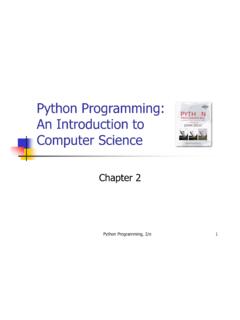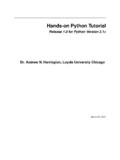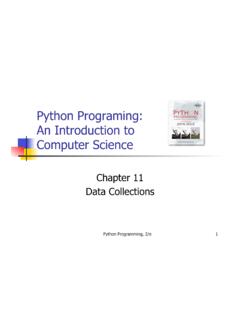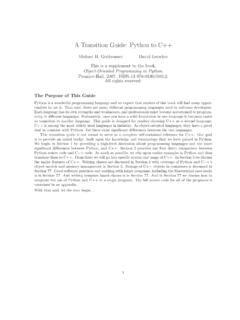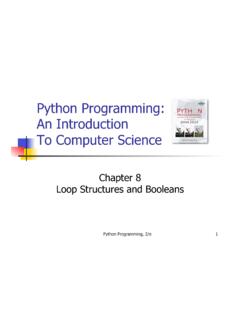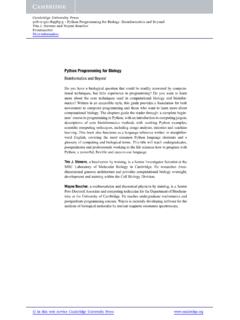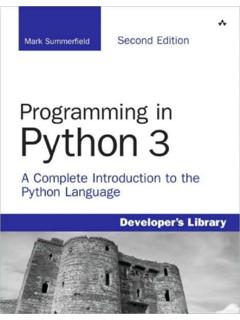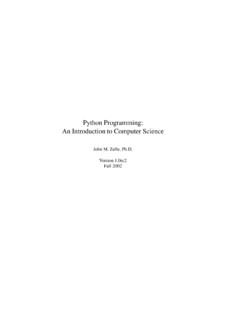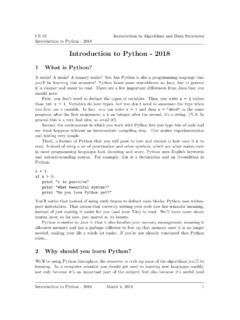Transcription of Python Programming: An Introduction to Computer Science
1 Python programming , 2/e1 Python Programming: An Introduction toComputer ScienceChapter 4 Objects and GraphicsPython programming , 2/e2 Objectives To understand the concept of objects and how they can be used to simplify programs. To be familiar with the various objects available in the graphics library. To be able to create objects in programs and call appropriate methods to perform graphical programming , 2/e3 Objectives (cont.) To understand the fundamental concepts of Computer graphics, especially the role of coordinate systems and coordinate transformations. To understand how to work with both mouse and text-based input in a graphical programming programming , 2/e4 Objectives (cont.)
2 To be able to write simple interactive graphics programs using the graphics programming , 2/e5 Overview Each data type can represent a certain set of values, and each had a set of associated operations. The traditional programming view is that data is passive it s manipulated and combined with active programming , 2/e6 Overview Modern Computer programs are built using an object-orientedapproach. Most applications you re familiar with have Graphical User Interfaces(GUI) that provide windows, icons, buttons and menus. There s a graphics library ( ) written specifically to go with this book. It s based on programming , 2/e7 The Object of Objects Basic idea view a complex system as the interaction of simpler objects.
3 An object is a sort of active data type that combines data and operations. Objects know stuff(contain data) and they can do stuff(have operations). Objects interact by sending each other programming , 2/e8 The Object of Objects Suppose we want to develop a data processing system for a college or university. We must keep records on students who attend the school. Each student will be represented as an programming , 2/e9 The Object of Objects The student object would contain data like: Name ID number Courses taken Campus Address Home Address GPA programming , 2/e10 The Object of Objects The student object should also respond to requests. We may want to send out a campus-wide mailing, so we d need a campus address for each student.
4 We could send the printCampusAddressto each student object. When the student object receives the message, it prints its own programming , 2/e11 Object of Objects Objects may refer to other objects. Each course might be represented by an object: Instructor Student roster Prerequisite courses When and where the class meetsPython programming , 2/e12 Object of Objects Sample Operation addStudent delStudent changeRoom programming , 2/e13 Simple Graphics programming This chapter uses the supplied with the supplemental materials. Two location choices In Python s Lib directory with other libraries In the same folder as your graphics programPython programming , 2/e14 Simple Graphics programming Since this is a library, we need to import the graphics commands>>> import graphics A graphics windowis a place on the screen where the graphics will appear.
5 >>> win = () This command creates a new window titled Graphics Window. Python programming , 2/e15 Simple Graphics programming GraphWinis an object assigned to the variable win. We can manipulate the window object through this variable, similar to manipulating files through file variables. Windows can be closed/destroyed by issuing the command>>> () Python programming , 2/e16 Simple Graphics programming It s tedious to use the graphics. notation to access the graphics library routines. from graphics import *The from statement allows you to load specific functions from a library module. * will load all the functions, or you can list specific programming , 2/e17 Simple Graphics programming Doing the import this way eliminates the need to preface graphics commands with graphics.
6 >>> from graphics import *>>> win = GraphWin() Python programming , 2/e18 Simple Graphics programming A graphics window is a collection of points called pixels(picture elements). The default GraphWin is 200 pixels tall by 200 pixels wide (40,000 pixels total). One way to get pictures into the window is one pixel at a time, which would be tedious. The graphics routine has a number of predefined routines to draw geometric programming , 2/e19 Simple Graphics programming The simplest object is the Point. Like points in geometry, point locations are represented with a coordinate system (x, y), where xis the horizontal location of the point and yis the vertical location.
7 The origin (0,0) in a graphics window is the upper left corner. X values increase from left to right, y values from top to bottom. Lower right corner is (199, 199) Python programming , 2/e20 Simple Graphics programming >>> p = Point(50, 60)>>> ()50>>> ()60>>> win = GraphWin()>>> (win)>>> p2 = Point(140, 100)>>> (win) Python programming , 2/e21 Simple Graphics programming >>> ### Open a graphics window>>> win = GraphWin('Shapes')>>> ### Draw a red circle centered at point (100, 100) with radius 30>>> center = Point(100, 100)>>> circ = Circle(center, 30)>>> ('red')>>> (win)>>> ### Put a textual label in the center of the circle>>> label = Text(center, "Red Circle")>>> (win)>>> ### Draw a square using a Rectangle object>>> rect = Rectangle(Point(30, 30), Point(70, 70))>>> (win)
8 >>> ### Draw a line segment using a Line object>>> line = Line(Point(20, 30), Point(180, 165))>>> (win)>>> ### Draw an oval using the Oval object>>> oval = Oval(Point(20, 150), Point(180, 199))>>> (win) Python programming , 2/e22 Using Graphical Objects Computation is preformed by asking an object to carry out one of its operations. In the previous example we manipulated GraphWin, Point, Circle, Oval, Line, Text and Rectangle. These are examples of programming , 2/e23 Using Graphical Objects Each object is an instance of some class, and the classdescribes the properties of the instance. If we say that Augie is a dog, we are actually saying that Augie is a specific individual in the larger classof all dogs.
9 Augie is an instanceof the dog programming , 2/e24 Using Graphical Objects To create a new instance of a class, we use a special operation called a constructor.<class-name>(<param1>, <param2>, ..) <class-name>is the name of the class we want to create a new instance of, Circle or Point. The parameters are required to initialize the object. For example, Point requires two numeric programming , 2/e25 Using Graphical Objects p = Point(50, 60)The constructor for the Point class requires to parameters, the xand ycoordinates for the point. These values are stored as instance variablesinside of the programming , 2/e26 Using Graphical Objects Only the most relevant instance variablesare shown (others include the color, window they belong to, etc.)
10 Python programming , 2/e27 Using Graphical Objects To perform an operation on an object, we send the object a message. The set of messages an object responds to are called the methodsof the object. Methods are like functions that live inside the object. Methods are invoked using dot-notation:<object>.<method-name>(<param1>, <param2>, ..) Python programming , 2/e28 Using Graphical Objects () () returns the xand yvalues of the point. Routines like these are referred to as accessorsbecause they allow us to access information from the instance variables of the programming , 2/e29 Using Graphical Objects Other methods change the stateof the object by changing the values of the object s instance variables.
